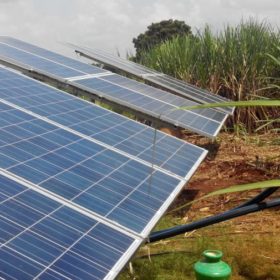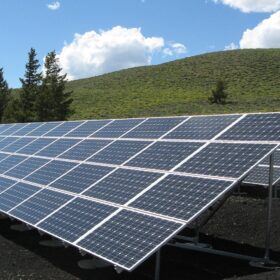International Solar Alliance convenes meeting of regional committee for Latin America and Caribbean region
The Fifth Meeting of the ISA Regional Committee for Latin America and the Caribbean Region took place this week, convened by the International Solar Alliance (ISA). Its primary objective was translating ambitious solar energy goals into concrete results while addressing pertinent regional issues. The meeting was presided over by Tania Masea, vice minister for new […]
PM KUSUM scheme hits 2.45 lakh solar pumps milestone
As on June 30, 2023, around 2.45 lakh agriculture pumps have been installed or solarized under PM KUSUM (Pradhan Mantri Kisan Urja Suraksha evam Utthaan Mahabhiyan) Scheme.
11,000 residents in Nepal’s Madhesh province gain access to clean water through solar energy
Solar-powered water pumps with a total capacity of 186 kWp have been installed in the Sarlahi and Siraha districts, benefitting 11,865 residents. The projects are a collaborative effort of Nepal’s Alternative Energy Promotion Centre (AEPC), the Government of Japan, and the United Nations Development Programme (UNDP).
$30.3 billion market potential for solar pumps, dryers in India
A new report states solar-powered pumps (higher capacity and micro-pumps) offer a $28 billion market potential in India, the maximum among all mature decentralized renewable energy (DRE) livelihood applications. Solar dryers have the second-largest deployment potential at $2.3 billion.
MAHAPREIT, GEAPP partner on 1 GW of solar projects in Maharashtra
Global Energy Alliance for People and Planet (GEAPP) and Mahatma Phule Renewable Energy and Infrastructure Technology Ltd (MAHAPREIT) have signed a Memorandum of Intent (MoI) to implement 1 GW of solar projects across Maharashtra.
ISA, UNDP launch pilot projects on farmland solar in ten African member countries
International Solar Alliance (ISA) and United Nations Development Programme (UNDP) will implement the programme over the next two years, with the $2 million fund jointly secured by them.
Tata Power Renewable completes $525 million equity fundraising from BlackRock, Mubadala
The investment will fund Tata Power Renewable’s aggressive growth plans as it targets over 20 GW of renewables assets and a market-leading position in the rooftop and electric vehicle charging space across India over the next five years.
Uttar Pradesh targets 22 GW of solar in next five years
The state government has announced its Solar Policy 2022, which places a special focus on the setting up of solar parks with storage systems. The policy also provides big incentives for the adotion of rooftop solar systems and the solarization of tubewells for agriculture.
Tata Power targets 10 GW of renewables portfolio in Rajasthan in next five years
Tata Power is looking to expand its renewable power portfolio in Rajasthan to 10 GW in the next five years, from around 5 GW at present. It will also set up solar manufacturing units in the state.
Making India a manufacturing hub for solar-based, decentralized energy products
A new report by GOGLA highlights the opportunities and challenges in establishing local manufacturing and assembly of solar-based decentralized energy solutions in India. It also explores the actions needed to maximize available opportunities.














